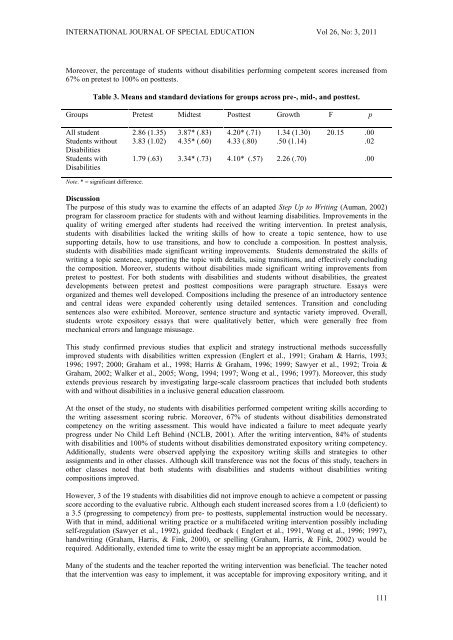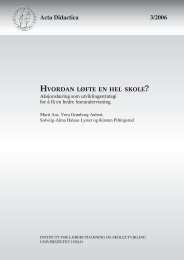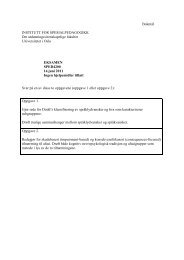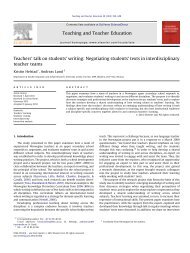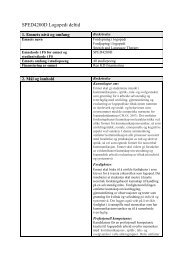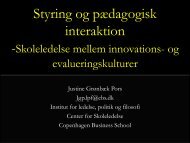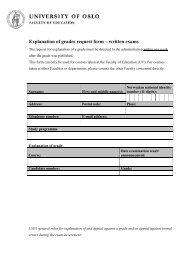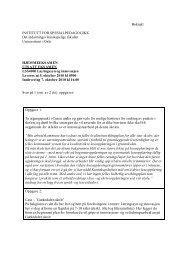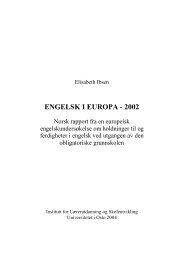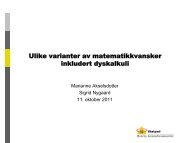International Journal Special Education
International Journal Special Education
International Journal Special Education
You also want an ePaper? Increase the reach of your titles
YUMPU automatically turns print PDFs into web optimized ePapers that Google loves.
INTERNATIONAL JOURNAL OF SPECIAL EDUCATION Vol 26, No: 3, 2011Moreover, the percentage of students without disabilities performing competent scores increased from67% on pretest to 100% on posttests.Table 3. Means and standard deviations for groups across pre-, mid-, and posttest.Groups Pretest Midtest Posttest Growth F pAll student 2.86 (1.35) 3.87* (.83) 4.20* (.71) 1.34 (1.30) 20.15 .00Students without 3.83 (1.02) 4.35* (.60) 4.33 (.80) .50 (1.14) .02DisabilitiesStudents withDisabilities1.79 (.63) 3.34* (.73) 4.10* (.57) 2.26 (.70) .00Note. * = significant difference.DiscussionThe purpose of this study was to examine the effects of an adapted Step Up to Writing (Auman, 2002)program for classroom practice for students with and without learning disabilities. Improvements in thequality of writing emerged after students had received the writing intervention. In pretest analysis,students with disabilities lacked the writing skills of how to create a topic sentence, how to usesupporting details, how to use transitions, and how to conclude a composition. In posttest analysis,students with disabilities made significant writing improvements. Students demonstrated the skills ofwriting a topic sentence, supporting the topic with details, using transitions, and effectively concludingthe composition. Moreover, students without disabilities made significant writing improvements frompretest to posttest. For both students with disabilities and students without disabilities, the greatestdevelopments between pretest and posttest compositions were paragraph structure. Essays wereorganized and themes well developed. Compositions including the presence of an introductory sentenceand central ideas were expanded coherently using detailed sentences. Transition and concludingsentences also were exhibited. Moreover, sentence structure and syntactic variety improved. Overall,students wrote expository essays that were qualitatively better, which were generally free frommechanical errors and language misusage.This study confirmed previous studies that explicit and strategy instructional methods successfullyimproved students with disabilities written expression (Englert et al., 1991; Graham & Harris, 1993;1996; 1997; 2000; Graham et al., 1998; Harris & Graham, 1996; 1999; Sawyer et al., 1992; Troia &Graham, 2002; Walker et al., 2005; Wong, 1994; 1997; Wong et al., 1996; 1997). Moreover, this studyextends previous research by investigating large-scale classroom practices that included both studentswith and without disabilities in a inclusive general education classroom.At the onset of the study, no students with disabilities performed competent writing skills according tothe writing assessment scoring rubric. Moreover, 67% of students without disabilities demonstratedcompetency on the writing assessment. This would have indicated a failure to meet adequate yearlyprogress under No Child Left Behind (NCLB, 2001). After the writing intervention, 84% of studentswith disabilities and 100% of students without disabilities demonstrated expository writing competency.Additionally, students were observed applying the expository writing skills and strategies to otherassignments and in other classes. Although skill transference was not the focus of this study, teachers inother classes noted that both students with disabilities and students without disabilities writingcompositions improved.However, 3 of the 19 students with disabilities did not improve enough to achieve a competent or passingscore according to the evaluative rubric. Although each student increased scores from a 1.0 (deficient) toa 3.5 (progressing to competency) from pre- to posttests, supplemental instruction would be necessary.With that in mind, additional writing practice or a multifaceted writing intervention possibly includingself-regulation (Sawyer et al., 1992), guided feedback ( Englert et al., 1991, Wong et al., 1996; 1997),handwriting (Graham, Harris, & Fink, 2000), or spelling (Graham, Harris, & Fink, 2002) would berequired. Additionally, extended time to write the essay might be an appropriate accommodation.Many of the students and the teacher reported the writing intervention was beneficial. The teacher notedthat the intervention was easy to implement, it was acceptable for improving expository writing, and it111


